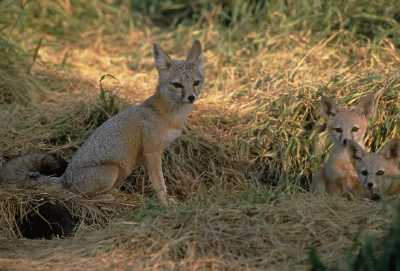 San Joaquin Kit Fox San Joaquin Kit FoxVulpes macrotis mutica
Description
The largest subspecies of kit
fox, the San Joaquin Kit Fox can reach a length
of 32 inches, including the tail, a height of 12
inches at the shoulder, and a weight of 5 pounds.
Fur color is light buff to
grayish along the back and tail; gray, rust, or
yellowish along the sides; and whitis on the
belly. The color tends to become darker in the
summer and lighter in the winter. The backs of
the ears and tip of the tail are black in both
winter and summer.
Like other kit foxes, the San
Joaquin has large ears set close together, a
slender body, and long legs. Its most distinctive
features are its hairy paw pads, which allow them
to get better traction on sandy soil.
 Distribution and Habitat Distribution and Habitat
Believed to have once been
fairly common throughout the San Joaquin Valley
of California, the San Joaquin Kit Fox is now
restricted to the eastern side of that valley,
with the majority being found in just six
counties. Human activity, including construction
of subdivisions, roads, etc., continues to affect
the San Joaquin's range, and the overall
population is currently being broken into
individual, relatively isolated, subpopulations.
The San Joquin Kit Fox prefers
grasslands and scrublands, but will adapt to life
on the fringes of populated areas if there are
enough suitable denning locations.
Listed as endangered on both
national and California lists, the total wild
population of San Joaquin Kit Fox is believed to
number less than 7,000 individuals.
Habits and Behaviors
Although it is primarily
nocturnal, the San Joaquin Kit Fox may be seen
during the day in the spring and early summer.
Like other kit foxes, the San
Joaquin lives in a den. While a San Joaquin will
excvate its own den (in loose soil), it will also
take advantage of a burrow or den originally
excavated by another animal. It will also take
advantage of man-made sites such as irrigation
pipes, drainage culverts, crawl spaces under
buildings, etc. The fox will change dens
frequently, with some individuals known to change
dens as often as every 2 or 3 days. Whether built
from scratch or adapted from a pre-existing den,
each den is itself quite complex, with multiple
chambers and entrances.
While a mating pair may stay
together year round, the individuals will not
typically share a den.
Individual kit fox ranges vary
in size depending on availability of food, but
the average is 1 or 2 square miles.
Reproduction
San Joaquin Kit Foxes mate from
December into March. The mother gives birth to
3-5 pups in a specially-built den. The pups
remain in the den until being weaned at one
month, during which time the male brings food to
the female. Although they can hunt for themselves
at 4-5 months, the pups may stay with their birth
parents through raising of the next litter.
Sexual maturity is reached at about 22 months,
and the average maximum lifespan in the wild is 7
years.
Diet
San Joaquin Kit Foxes prey on a
variety of rodents, as well as squirrels, hares
and rabbits, birds, lizards, and even insects;
they will also eat grasses and other vegetation.
Scientific
Classification
phylum Chordata
subphylum Vertebrata
class
Mammalia
order
Carnivora
family
Canidae
genus & species Vulpes macrotis mutica
Questions or comments about
this page?
|



